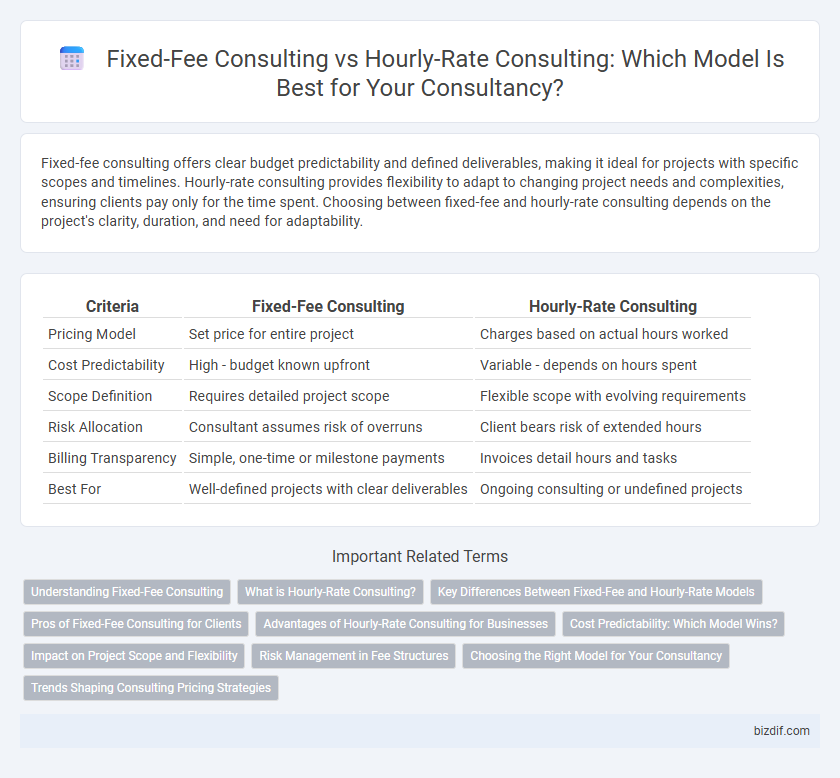Fixed-fee consulting offers clear budget predictability and defined deliverables, making it ideal for projects with specific scopes and timelines. Hourly-rate consulting provides flexibility to adapt to changing project needs and complexities, ensuring clients pay only for the time spent. Choosing between fixed-fee and hourly-rate consulting depends on the project's clarity, duration, and need for adaptability.
Table of Comparison
| Criteria | Fixed-Fee Consulting | Hourly-Rate Consulting |
|---|---|---|
| Pricing Model | Set price for entire project | Charges based on actual hours worked |
| Cost Predictability | High - budget known upfront | Variable - depends on hours spent |
| Scope Definition | Requires detailed project scope | Flexible scope with evolving requirements |
| Risk Allocation | Consultant assumes risk of overruns | Client bears risk of extended hours |
| Billing Transparency | Simple, one-time or milestone payments | Invoices detail hours and tasks |
| Best For | Well-defined projects with clear deliverables | Ongoing consulting or undefined projects |
Understanding Fixed-Fee Consulting
Fixed-fee consulting offers a predetermined price for a defined scope of work, ensuring budget predictability and minimizing financial surprises. This pricing model aligns consultant incentives with project outcomes rather than time spent, promoting efficiency and delivering clear value. Clients benefit from transparent cost structures and consultants gain clarity on deliverables, fostering trust and streamlined project management.
What is Hourly-Rate Consulting?
Hourly-rate consulting involves charging clients based on the actual time spent on their projects, typically measured in hours or fractions of hours. This model offers flexibility for clients with variable project scopes and allows consultants to be compensated accurately for the work performed. Hourly rates vary widely depending on the consultant's expertise, industry, and geographic location, often ranging from $50 to over $300 per hour.
Key Differences Between Fixed-Fee and Hourly-Rate Models
Fixed-fee consulting offers a predetermined price for the entire project, ensuring budget predictability and aligning consultant incentives with project completion efficiency. Hourly-rate consulting charges clients based on actual hours worked, providing flexibility for scope changes but potentially leading to cost uncertainties. Choosing between these models depends on project clarity, risk tolerance, and client preference for pricing transparency versus adaptability.
Pros of Fixed-Fee Consulting for Clients
Fixed-fee consulting offers clients predictable budgeting and eliminates the risk of unexpected costs, ensuring financial transparency throughout the project. Clients benefit from clearly defined deliverables and timelines, which fosters accountability and efficient project management. This pricing structure incentivizes consultants to complete work swiftly without compromising quality, aligning their goals with client success.
Advantages of Hourly-Rate Consulting for Businesses
Hourly-rate consulting offers businesses greater flexibility by allowing payment strictly for the actual time spent on projects, leading to more precise budgeting and cost control. This model enables consultants to adapt quickly to changing project scopes without renegotiating fees, fostering transparency and accountability in billing. Hourly-rate consulting is especially advantageous for businesses with evolving or undefined needs, ensuring they pay proportionally to the consulting services utilized.
Cost Predictability: Which Model Wins?
Fixed-fee consulting offers superior cost predictability by providing a set price for the entire project, eliminating surprises related to fluctuating hours or scope changes. Hourly-rate consulting can result in variable expenses, making budgeting challenging for clients with limited financial flexibility. For businesses prioritizing precise budget management, fixed-fee models typically deliver more reliable financial control and transparency.
Impact on Project Scope and Flexibility
Fixed-fee consulting provides clear budget boundaries and defined deliverables, reducing scope creep but limiting flexibility for changes during the project. Hourly-rate consulting offers greater adaptability to evolving project requirements, allowing scope adjustments based on client feedback and unforeseen challenges. Selecting between fixed-fee and hourly-rate models depends on the project's complexity and the desired balance between cost certainty and scope flexibility.
Risk Management in Fee Structures
Fixed-fee consulting offers predictable costs that reduce financial uncertainty for clients, mitigating the risk of budget overruns associated with hourly-rate consulting. Hourly-rate consulting carries the risk of escalating fees due to unforeseen project complexities, impacting overall project cost control. Effective risk management in fee structures involves aligning payment models with project scope clarity and risk tolerance, ensuring financial transparency and accountability.
Choosing the Right Model for Your Consultancy
Choosing the right consulting fee model depends on your project scope, client preferences, and risk tolerance. Fixed-fee consulting offers predictability and incentivizes efficiency, while hourly-rate consulting provides flexibility and detailed billing transparency. Assess project complexity and client expectations to determine whether a fixed-fee or hourly-rate structure maximizes value and profitability for your consultancy.
Trends Shaping Consulting Pricing Strategies
Fixed-fee consulting gains traction as clients seek budget predictability and transparent cost structures, enhancing project scope clarity. Hourly-rate consulting remains prevalent, favored for its flexibility in dynamic or undefined project phases, accommodating fluctuating workloads. Emerging trends highlight hybrid models and value-based pricing, driven by technology integration and client demand for outcome-focused engagement.
Fixed-fee consulting vs Hourly-rate consulting Infographic

 bizdif.com
bizdif.com